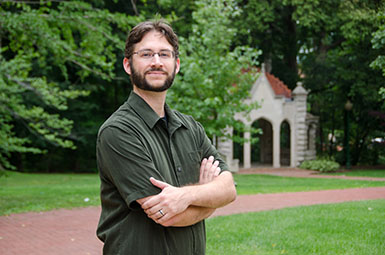Extended reality lab to expand Media School production, research possibilities

Media School students and faculty will see new possibilities in areas such as film, video game, and sports media production, and digital humanities and artificial intelligence research with the establishment of the Kinetic Imagery and Extended Reality Lab.
IU Bloomington Provost Rahul Shrivastav announced plans for the KIX Lab during his State of the Campus address to the Bloomington Faculty Council on Tuesday. The facility will feature “The Wall,” a 24-foot LED immersive soundstage that displays an environment that can move with performers by using camera tracking.
Media School Dean David Tolchinsky expects the school to propose new graduate programs in kinetic imagery and extended reality, in addition to making the technology available to faculty and graduate students in existing programs.
“The KIX Lab builds on The Media School’s principles of synergy: understanding the relationship between words, sounds, and images, and adapting stories to evolving forms of media,” Tolchinsky said. “This initiative will introduce new potential to infuse critical thought into technology, challenge our students and faculty to experiment with media genres, and transform their way of thinking about storytelling. To cross boundaries and create new forms of media.”
Faculty hiring will commence this year, with construction to follow. While KIX is an interdisciplinary initiative among eight units, at least one of the new faculty hires will be part of The Media School.
Virtual sets have been gaining popularity in the entertainment industry and have been used for hits such as “The Mandalorian” and “The Batman.” They’re adaptable for a multitude of uses and are a sustainable alternative to set-building.
The lab will offer students and faculty a platform to experiment with cinematic techniques and virtual set design, and will encourage research and development in new film production technologies. Tolchinsky sees potential for advancements in computer-generated imagery, motion capture, and new forms of storytelling.
Opportunities in sports media include sports analytics visualization using data analytics and visualization tools for sports performance analysis, fan engagement, and broadcasting enhancements. There’s also potential for developing virtual reality applications for athlete training and sports simulation for sports enthusiasts.

“The ability to effectively use data visualization is key in most visual sports media, including broadcast and online writing,” said Associate Professor Galen Clavio, director of the National Sports Journalism Center. “We’re excited about having the computing power and potential to create things that will help fans better understand what’s going on within the games they love.”
Video game design is among the most-recognized applications for extended reality technology. The interdisciplinary nature of KIX expands opportunities to use game design in education or even health care, said Senior Lecturer Will Emigh, director of The Media School’s game design program.

Emigh has done this before with games like “TubeRunner,” which he helped develop for children in rehabilitation. Patients who need to work on motion and balance simulate traveling through a tunnel, leaning and reaching up to grab rewards such as coins.
Tolchinsky, who previously served as founding director of Northwestern University’s Pritzker Pucker Studio Lab for the Promotion of Mental Health via Cinematic Arts, is particularly interested in the KIX Lab’s potential for impacting treatment and understanding of mental health conditions. Treatment could be a variation on games like “TubeRunner” or the creation of virtual therapeutic environments. Media can foster understanding of mental health conditions by simulating the experience of living with a condition so others can experience it.
Facilities can be a barrier to these types of interdisciplinary projects, Emigh said. With “TubeRunner” and other previous projects, the process was piecemeal and dependent on resources spread across locations. KIX will bring it all into one place.
“Having a space where we can get all these people together and think about things outside of the obvious context is great,” Emigh said. “This gives us the opportunity to make connections that you wouldn’t otherwise make, which leads to the really cool and innovative stuff.”

Those kinds of connections are exactly what Associate Professor Rachel Plotnick makes through her scholarship. She studies the relationship between technology and culture, and is part of the interdisciplinary AI and Digital Futures Team on campus. Together, they’re investigating how the humanities can understand and leverage AI technologies, which has so far been primarily relegated to the science and technology sector.
“How can we think about the question of what it means to be creative, and what does it mean to be creative when machines can create things?” she asked. “There’s enormous potential to study creativity and to think creatively with AI tools in an environment like the KIX Lab.”
And then there’s the question of such applications’ societal impacts. The lab’s potential for simulating creation and imagination could allow students and faculty to ask these questions and imagine what’s possible

